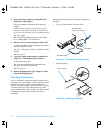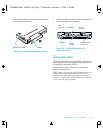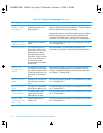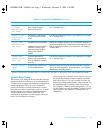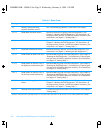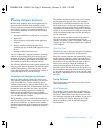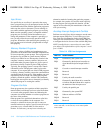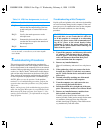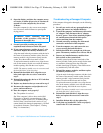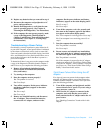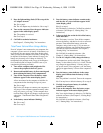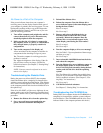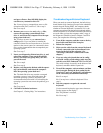
3-10 Dell Inspiron 3000 Reference and Troubleshooting Guide
Input Errors
If a specific key or set of keys is pressed at the wrong
time, a program may give you unexpected results. See the
documentation that came with the application program to
make sure the values or characters you are entering do
not conflict with the application program you are using.
Make sure the operating system is compatible with the
programs you use. Keep in mind that whenever you
change the parameters of the computer’s operating sys-
tem, you may affect the successful operation of the
programs. Sometimes, after modifying the operating sys-
tem, you may need to reinstall a program that no longer
runs properly.
Memory-Resident Programs
There are a variety of utilities and supplementary pro-
grams that can be loaded either when the computer boots
or from an operating system prompt. These programs are
designed to stay resident in system memory and thus
always be available for use. Because they remain in the
computer’s memory, memory conflicts and errors can
result when other programs require use of all or part of
the memory already occupied by these TSR programs.
Typically, the operating system’s start-up files contain
commands to start TSR programs when you boot the
computer. If you suspect that one of these TSR programs
is causing a memory conflict, remove the commands that
start them from the start-up file. If the problem you were
experiencing does not recur, one of the TSR programs
probably created the conflict. Add the TSR commands
back into the start-up files one at a time until you identify
which TSR program is creating the conflict.
Program Conflicts
Some programs may leave portions of their setup infor-
mation behind, even though you have exited from them.
As a result, other programs cannot run. Rebooting the
computer can confirm whether or not these programs are
the cause of the problem.
Other programs use specialized subroutines called driv-
ers that can cause problems in the computer. For
example, a variation in the way the data is sent to an
external monitor may require a special screen driver pro-
gram that expects a certain kind of video mode or
monitor. In such cases, you may have to develop an
alternative method of running that particular program—
for example, the creation of a boot file made especially
for that program. For help with this situation, call the
support service offered by the manufacturer of the soft-
ware you are using.
Avoiding Interrupt Assignment Conflicts
Problems can arise if two devices attempt to use the same
interrupt request (IRQ) line. To avoid this type of con-
flict, check the documentation for the default IRQ line
setting for each installed device. Then consult Table 3-4
to configure the device for one of the available IRQ lines.
NOTE: Installed devices cannot share the same COM
port address. The default address of the computer’s serial
port is COM1.
Table 3-4. IRQ Line Assignments
IRQ Line Used/Available
IRQ0 Generated by the system timer
IRQ1 Generated by the keyboard controller to
signal that the keyboard output buffer is
full
IRQ2 Cascade to second interrupt controller
IRQ3 Reserved
IRQ4 Reserved
IRQ5 Used by the audio controller
IRQ6 Generated by the diskette drive controller
to indicate that the diskette drive requires
the attention of the microprocessor
IRQ7 Used by the parallel port
IRQ8 Generated by the system RTC
IRQ9 Software redirect to INT0A
IRQ10 Reserved
IRQ11 Reserved
NOTE: For the full name of an abbreviation or acronym
used in this table, see the Glossary in the online System
User’s Guide.
55899BK1.BK : 55899c31.fm Page 10 Wednesday, February 4, 1998 1:20 PM



